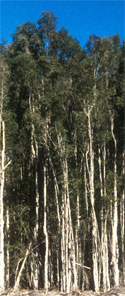About Melaleuca
Melaleuca (scientific name: Melaleuca quinquenervia), also known as punk tree, paperbark tree, or cajeput, is an invasive, exotic nuisance plant in South Florida. Originally from Australia, it was introduced into Florida about 100 years ago and now infests approximately 500,000 acres in the greater Everglades region of the state. It is such a pest that the United States government and the State of Florida list it as a noxious weed and prohibit the sale, possession, or transportation of the plant (see FAQs for more information).
Melaleuca is an evergreen tree that reaches heights of up to 100 feet. It is easily identified by its layered and peeling, whitish-brown bark, creamy white "bottle brush" flowers, woody seed capsules containing up to 300 tiny brown seeds, and lance-shaped grayish-green leaves that smell of camphor when crushed.
Melaleuca is well adapted to fire. Its paper bark burns easily but also protects the tree and helps it survive. The bark carries flames up to the canopy where the leaves are. Melaleuca leaves have a high volatile oil content and fuel very hot fires. Fire triggers seed release. Melaleuca seeds germinate easily in the newly burned ground, and soon there is even more melaleuca than there was before the fire! Read more about melaleuca and fire.
Melaleuca tends to grow quickly and close together, forming dense stands. These infestations can displace native vegetation, degrade wildlife habitat, alter fire regimes, and elevate soil levels, which affects water flow.
The TAME Project
- Welcome
- About Melaleuca
- Melaleuca & Fire
- Collaborators
Primary Funding Agency

Melaleuca Trees

